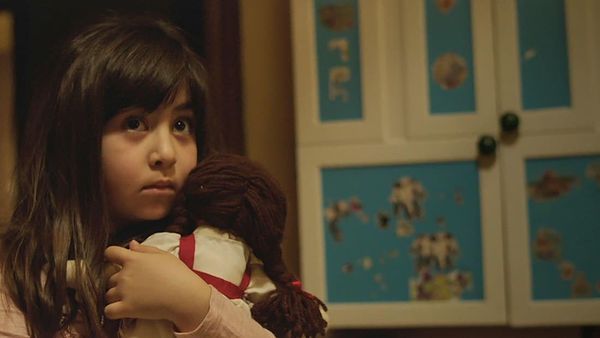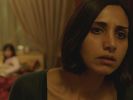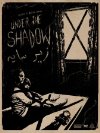Eye For Film >> Movies >> Under The Shadow (2016) Film Review
Under The Shadow
Reviewed by: Amber Wilkinson

Real world horror manifests itself in supernatural guise in Babak Anvari's debut feature, which was squirrelled away in Sundance's Midnight section due to its genre content but which could easily have been put in competition. Like its kindred fearful spirits The Babadook and The Witch it draws on psyches under stress to straddle the disturbing netherworld where what's imagined and real meet with murderous intent.
There is, sadly, still no shortage of Middle East conflict for Anvari to use but he goes back in time - recalling his own childhood in Tehran - to set his film in 1988 against the backdrop of the long-running Iran-Iraq war. He economically sets the scene with news footage from the time, showing the bombing campaign that brought the frontline to the front doorsteps of the residents of Tehran, whose watchful days alternate with interrupted nights as the wail of sirens sends them, scooped children in arms, scurrying for basement bomb shelters.

The situation for women is shown to be particularly bleak - a theme that builds through the film to a stinging indictment of the entire 1980s regime. Shideh (Narges Rashidi) is a smart woman with a good looking, attentive doctor husband (Bobby Naderi) and a cute-as-a-button daughter Dorsa (Avin Manshadi). They are a pretty typical middle-class family - with even a banned-by-the-regime VHS player in the house. But she has problems thanks to activity before the revolution that has seen her blackballed by medical college and branded a subversive. When her husband is called up to fight, she finds herself alone with Dorsa and when the realities of war literally hit home, things far more otherworldly than missiles start to go bump in the night.
Anvari takes us on the baby steps that show the mother and daughter relationship start to fracture. Dorsa feeds on her mother's fears, marrying them to her own landscape, a place where ancient and malevolent djinn spirits can blow in on the wind as easily as dust. Fear gets in a feedback loop, with Dorsa's imaginary conversations taking on a much more ominous tone that is only exacerbated when her doll goes missing - with the little girl adamant her mother has taken it. Meanwhile, the whisperings of a neighbour only stoke superstition when Shideh learns a djinn must possess an object belonging to someone in order to stalk them.
The sleeping and waking worlds begin to tumble together, with cinematographer Kit Fraser using his camera to add to the unsettling atmosphere, spinning the image at key moments or rocking it to ratchet tension. It is Anvari's control of the non-threatening that is particularly worthy of note, however. Making people jump is one thing - and he certainly achieves that with objects as innocuous as a toaster - but creating an innocent doll that never seems malevolent is a major achievement given the preconceptions everyone will bring to the cinema. He also finds the sweet spot between humour and horror, as when we see Shideh working out to a Jane Fonda video like a madwoman possessed, with Rashidi perfectly calibrating the slide of a smart woman into a chasm of psychological uncertainty.
The use of the djinn is also savvy, its non-corporeal presence often suggested by excellent work from the sound department rather than spelt out. Even when it does appear, it's as a drowning all-encompassing swathe of cloth - a perfect manifestation of maternal anxiety, exacerbated by the dire threats made to women who fail to wear the chador. Even though he sticks to the genre rules, Anvari sneaks plenty of social commentary under the surface so that the acknowledgement of unjustified, almost whimsical human malevolence becomes as disturbing as the djinn's more primal spirit.
Reviewed on: 02 Mar 2016
















